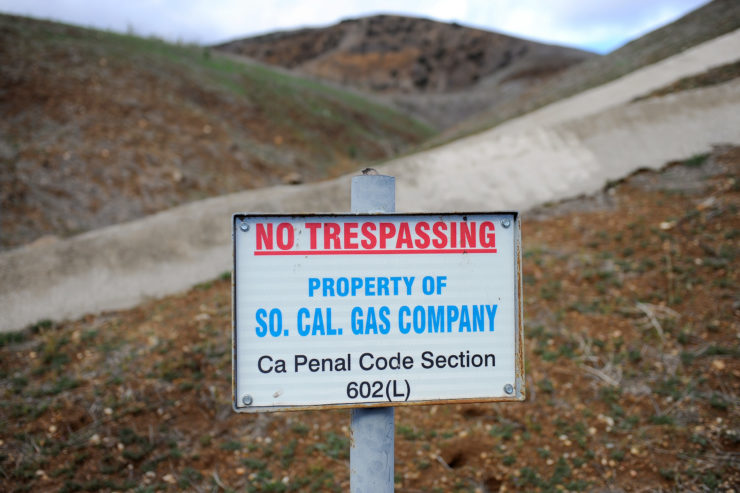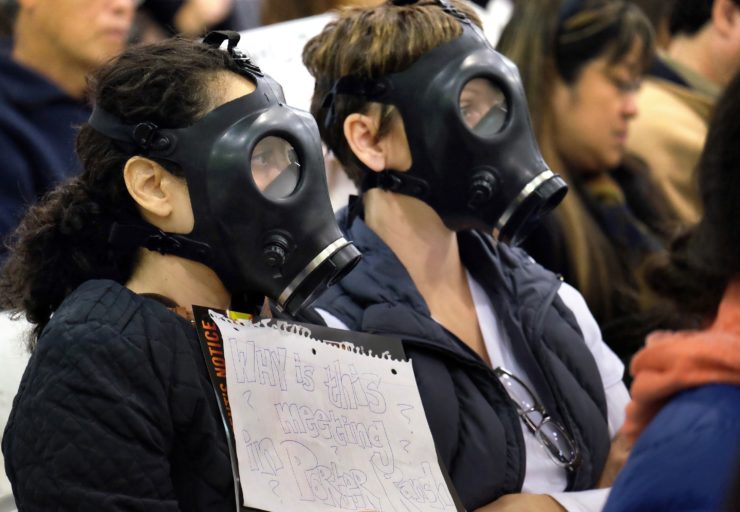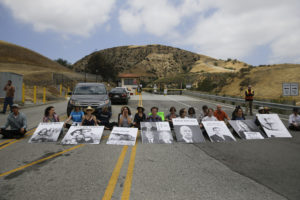
In this January 2016 photo, a sign declares the boundary line of the Southern California Gas Company gas fields where a gas well was leaking methane near the community of Porter Ranch, Calif.
For four months last winter, methane gas spewed silently and stealthily in a monumental leak from a natural gas storage facility into an affluent Southern California neighborhood. When it finally stopped in February, scientists called it the largest methane leak in U.S. history.
Residents of the Porter Ranch neighborhood, in the San Fernando Valley on the northern edge of Los Angeles, were understandably focused on the human health impacts of the leak, as was most news coverage.
But Nathaniel Rich, in a March 2016 New York Times Magazine article called “The Invisible Catastrophe,” saw the Porter Ranch gas leak as a microcosm of how we think and deal with global climate change.
The brilliance of Rich’s reporting and writing is that he had to make the invisible visible for readers. Unlike the 2010 British Petroleum Gulf oil spill, where people could see tangible evidence of damage, Rich said nothing looked out of place in Porter Ranch. The gas was invisible, and the long-term consequences aren’t quantifiable.
Nathaniel Rich, who has written for The Atlantic, Harper’s, The New York Times Magazine, Vice and others, is the author of two novels, including Odds Against Tomorrow, which explores the nature of society and humanity in the wake of natural catastrophe.
Rich spoke with me by phone about his reporting from Porter Ranch. The following are edited and condensed excerpts of that conversation:

Protesters wearing gas masks attend a hearing over a gas leak near the Porter Ranch community.
Much of the coverage about the leak has focused on the possible health effects. You homed in on the environmental effects. What led you down that path?
Going in, I try not to have any sort of agenda or clear idea even of what a story is going to be. I did want to understand the relationship between the climate fears and the health fears in the community. And so I focused a lot of my reporting on trying to understand that question. But frankly, it was easy to sort out, because basically everybody there was terrified about their health and didn’t care about the climate questions, which is totally understandable given the health effects people were suffering. But that was striking to me. That’s something I tried to pursue and understand.
I think it’s funny that in fiction, if you see a familiar narrative like that, it becomes genre or considered bad writing when the writer is so obviously following a formula. But in journalism, I feel like often the formula is what’s taught. But I don’t think the literary standards are different. When a reader is reading something, they can see the artifice in it and feel familiar patterns. It’s boring, and there’s no point in reading it.
The anxiety and the fear is very much the subject of the piece because I feel like the gas leak is a stand-in for climate change in general. Because we know it’s happening. We know it’s serious, and we know it’s going to change everything and have a great effect on us in the future and on future generations. Yet the exact contours of what that will mean or what that will be like is very difficult for us to visualize and to accept intellectually. The same exact anxiety that one feels about the future of this climate is seen in Los Angeles and in Porter Ranch, where people are trying to wrap their heads around the fact that there’s this horrific environmental disaster going on in their little suburban community despite the fact that everything looks fine. The people in Porter Ranch have found themselves in very much the same position in which we all find ourselves. The irony of it is that the long-term climate effects caused by the methane leak in Porter Ranch will affect the people in Porter Ranch no more than it will affect you or me. Climate is not local.
What was your understanding of climate science before this piece?
I don’t claim any expertise. I think it’s a big problem that people think you need to have a background in biochemistry in order to understand these issues. It would be helpful in order to understand some of the more sophisticated problems of climate, but a background in biochemistry is not all required to understand the basic ideas. That’s a failure of the imagination more than a failure of science education.
Your piece doesn’t focus on one particular resident. How did you decide to not use a central character to drive the narrative?
I think that’s a cliché. There’s something boring about that idea. I mean, it can work depending on the story, but I wanted to give a sense of this whole community.
So many other stories have been written about the gas leak. In any disaster, it starts with a person and their sob story and takes it from there. I think it’s very tedious to read stories like that. I want as a writer to not fall into those patterns because they are not conducive to original thought. You start to get into a familiar call-and-response type thing. I try to avoid that as much as possible. If it’s boring to me, then it’s going to be boring to readers.
I think it’s funny that in fiction, if you see a familiar narrative like that, it becomes genre or considered bad writing when the writer is so obviously following a formula. But in journalism, I feel like often the formula is what’s taught. But I don’t think the literary standards are different. When a reader is reading something, they can see the artifice in it and feel familiar patterns. It’s boring, and there’s no point in reading it. It’s strange that the level of discipline enforced in fiction is not enforced in journalism. There seems to be a lower standard … and it shouldn’t be [like that]. What we are talking about is good writing. If something is familiar or hackneyed, there’s no surprise in it. The nature of good writing is that there are surprises. That’s what makes something good. You are doing yourself a disservice if you are not testing yourself to do something new and original.

People protest against Southern California Gas Co. in the Porter Ranch community.
You were assigned the story in January, so you had a pretty quick turnaround. What was your reporting and writing process?
I went to Porter Ranch. I was there for about a week. I had a few sources. I had a few local politicians. I spoke to local public health people. I spent a day going around with this UCLA scientist and his team. They were monitoring the community because he was so frustrated with what had been going on for the first couple months of the leak that he got a grant to put testing apparatuses in people’s backyards. So I spent a day going around with him. I thought at one point that might be the piece but there wasn’t really enough there to support a whole feature.
Then I just walked up to strangers. I walked around the town, walked up to people’s houses and knocked on their doors. Some people were open to talking. Some people were not. It’s not socially the easiest thing to do, but it was how I found some of the best material.
For the writing part, I do what I always do. I go through my notes and make an outline. I write down all of the things I found most surprising or interesting, and then I make an outline, put it into a structure. In this case, I outlined pretty heavily. I didn’t depart too much from it.
I sort of give myself some time to let it sit in and some time to pass. One thing I often do, even before going through my notes, I’ll look at other stuff I’ve marked in the moment as I’m taking notes and writing people’s quotes down. Even before going through my notes, I try to think back and remember what stood out to me the most. I find that’s a good way of figuring out what’s most surprising about it.
The rule of thumb in journalism is to show, not tell. But for this piece, you didn’t have much to show because you were dealing with invisible gases and abstract climate concepts. Yet, you do manage to find concrete examples for the reader to visualize. How did you come up with these comparisons?
The brilliance of Rich’s reporting and writing is that he had to make the invisible visible for readers.
The methane was leaking from Aliso Canyon at a rate of 44 metric tons per hour. By Thanksgiving, it had increased to 58 metric tons per hour, doubling the rate of methane emissions in the entire Los Angeles Basin. This fact takes some effort to absorb. It means that the steel straw seven inches in diameter plugged into Aliso Canyon was by itself producing twice the emissions of every power plant, oil and gas facility, airport, smoke stack and tailpipe in all of greater Los Angeles combined. … Over a 20-year period, methane is estimated to have a warming effect on earth’s atmosphere 84 times that of carbon dioxide. By that metric, the Aliso Canyon leak produced the same amount of global warming as 1,735,404 cars in a full year. During the four months the leak lasted — 25 days longer than the BP oil spill in the Gulf of Mexico — the leak contributed roughly the same amount of warming as the greenhouse gas emissions produced by the entire country of Lebanon. If well SS-25 were a nation-state, it would have contributed to global climate change at a rate exceeding that of Senegal, Laos, Lithuania, Estonia, Zimbabwe, Albania, Brunei, Slovenia, Nicaragua, Panama, Jamaica, Latvia, Georgia, Guinea, Equatorial Guinea, Costa Rica, Honduras, Tajikistan, Armenia and Iceland. SS-25 would rank just behind Mali.
I think any climate scientist ends up trying to look for metaphors to make some of these issues understandable. I reported the piece before the leak had stopped, but by the time I started writing, the leak was capped. Once it had stopped, there were some more final numbers about how much methane had gotten into the atmosphere. And so I found the total number, and I tried to quantify it. It was at the level of a nation-state. And then I just went down the list to understand where it would be. I did some very basic math.
The piece is very much about this question about how do you make sense of these numbers. How does one make sense of risk assessment and probability and lagging effects? I think it’s very difficult, and I don’t think scientists are very good at it, so I tried to figure out the best ways to do it. I was just guessing around, trying to think what would be best visually or intellectually vivid to a reader with little understanding of climate science.
Katherine Knott is a native of Las Vegas who graduated from the Missouri School of Journalism in May 2016 with an emphasis on magazine journalism. She’s now interning at The Chronicle of the Higher Education.

